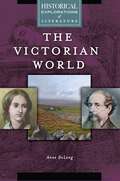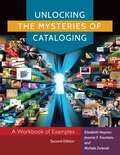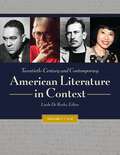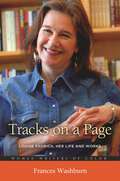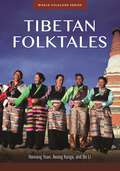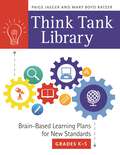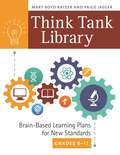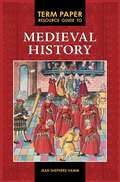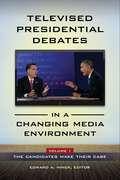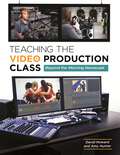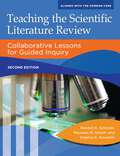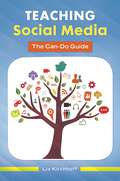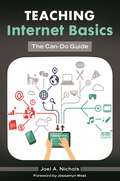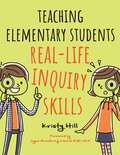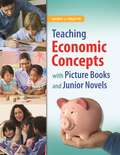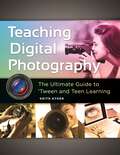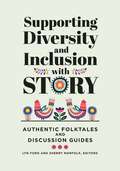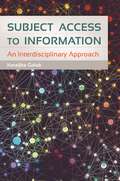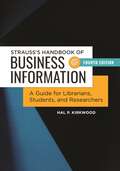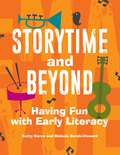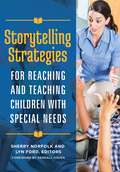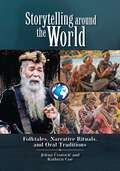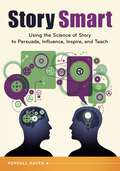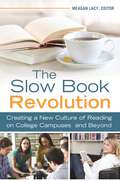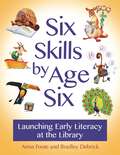- Table View
- List View
The Victorian World: A Historical Exploration of Literature (Historical Explorations of Literature)
by Anne DeLongAn indispensable resource for readers investigating Victorian literature and culture, this book offers a comprehensive summary of the historical, social, political, and cultural contexts of Victorian England.The Victorian era was a time of great social, scientific, and cultural change. The literary works of that period reflect that change and help us to better understand the Victorian world. This book examines the historical, political, social, and cultural contexts of several important Victorian literary works: Jane Eyre,, by Charlotte Brontë; Wuthering Heights,, by Emily Brontë; A Tale of Two Cities,, by Charles Dickens; and several poems by Elizabeth Barrett Browning, including "The Cry of the Children," "The Runaway Slave at Pilgrim's Point," "A Curse for a Nation," and Aurora Leigh..The volume provides historical explanations, literary analyses, and cultural context for each literary work, including primary documents from the nineteenth century. Topics investigated include women's rights, workers' rights, education reforms, marriage laws, race relations, inheritance and heredity, and other issues concerning gender, race, and class in the nineteenth century. Readers will gain a greater understanding of these major literary works as well as their historical context.
Unlocking the Mysteries of Cataloging: A Workbook of Examples
by Elizabeth Haynes Joanna F. Fountain Michele ZwierskiIdeal for students and both beginning and practicing catalogers in public, school, and academic libraries, this updated workbook offers targeted, hands-on exercises that enhance understanding of description, classification, subject analysis, subject heading application, and MARC 21 subject analysis.Like the first edition, this updated workbook has a straightforward goal: to help expand and improve the effectiveness of library catalogs. It is designed to supplement existing textbooks by providing exercises in AACR2r and RDA description, classification, subject analysis, and MARC protocols. Particular attention is given to problems that may arise when cataloging books as well as multimedia combinations, 3-D items, toys, natural objects, maps, printed and performed music, bilingual materials, and electronic files. Through the exercises, you will better understand the overall process of cataloging an item and making a record, the application of RDA in producing records, the steps for cataloging new media, and the differences in records using RDA or AACR2r.To enhance the exercises, the workbook incorporates photographs of real materials and offers questions for consideration. There is also a companion website with enlargeable color graphics. The site provides complete answer records and additional indexes for instructors to use in selecting examples for specific elements in the record. For students, new or advanced, selected MARC answer records are included, as are special lists, forms, and indexes leading to the tools any cataloger will need.Student ResourcesExercisesThe images from the exercises in the book are included in this section in a larger format for closer examination. ExercisesMARC TemplateFor use in drafting cataloging records for all types of elements. MARC TemplateInstructor's ResourcesMARC and RDA answer records are provided to instructors upon request. Please contact CustomerService@abc-clio.com for more information.
Twentieth-Century and Contemporary American Literature in Context [4 volumes]: [4 volumes]
by Linda De RocheThis four-volume reference work surveys American literature from the early 20th century to the present day, featuring a diverse range of American works and authors and an expansive selection of primary source materials.Bringing useful and engaging material into the classroom, this four-volume set covers more than a century of American literary history—from 1900 to the present. Twentieth-Century and Contemporary American Literature in Context profiles authors and their works and provides overviews of literary movements and genres through which readers will understand the historical, cultural, and political contexts that have shaped American writing. Twentieth-Century and Contemporary American Literature in Context provides wide coverage of authors, works, genres, and movements that are emblematic of the diversity of modern America. Not only are major literary movements represented, such as the Beats, but this work also highlights the emergence and development of modern Native American literature, African American literature, and other representative groups that showcase the diversity of American letters. A rich selection of primary documents and background material provides indispensable information for student research.
Tracks on a Page: Louise Erdrich, Her Life and Works (Women Writers of Color)
by Frances WashburnThis book details the intersections between the personal life and exceptional writing of Louise Erdrich, perhaps the most critically and economically successful American Indian author ever.Known for her engrossing explorations of Native American themes, Louise Erdrich has created award-winning novels, poetry, stories, and more for three decades. Tracks on a Page: Louise Erdrich, Her Life and Works examines Erdrich's oeuvre in light of her experiences, her gender, and her heritage as the daughter of a Chippewa mother and German-American father.The book covers Erdrich from her birth to the present, offering fresh information and perspectives based on original research. By interweaving biography and literary analysis, the author, who is herself Native American, gives readers a complete and nuanced understanding of the ways in which Erdrich's identity as a woman and an American Indian have influenced her life and her writing. Tracks on a Page is the first, book-length work to approach Erdrich and her works from a non-Euro-Western perspective. It contextualizes both life and writing through the lenses of American Indian history, politics, economics, and culture, offering readers new and intriguing ways to appreciate this outstanding author.
Tibetan Folktales (World Folklore Series)
by Haiwang Yuan Awang Kunga Bo LiThis collection of folktales provides readers with an extensive overview of the breadth of Tibetan culture, revealing the character of the region and its people as well as their traditional customs and values.Most Westerners are unlikely to travel to the mountainous region of East Asia and experience the Tibetan people and their culture directly. This book provides a way to experience and learn about this remote nation through carefully selected Tibetan folktales that provide readers with a unique glimpse into Tibet's culture, its people, and the land itself through the window of folklore. Providing a unique resource that can serve both as a storytime aid for educators who work with primary school students and a valuable reference for Eastern folklorists, Tibetan Folktales contains more than 30 traditional Tibetan stories that give readers a taste of the land, people, culture, history, religion, and psyche of this remote country. The tales are gathered from contemporary Tibetan storytellers and translated from written sources to represent the rich oral and written literary tradition of Tibet's culture. In addition, the book supplies tutorials for Tibetan crafts and games, a sample of recipes, and photographs and illustrations that create a multidimensional experience of Tibetan culture.
Think Tank Library: Brain-Based Learning Plans for New Standards, Grades K–5
by Paige Jaeger Mary Boyd RatzerTransform your library into a "think tank" by helping teachers create an active learning environment in which students question, investigate, synthesize, conclude, and present information based on Common Core standards.The rigors of today's mandated academic standards can repurpose your library's role as a steward of the Common Core State Standards (CCSS) at your school. This guide will help you help teachers present exciting, field-tested lessons for elementary grades K through 5, addressing developmental steps and individual differences in key competencies in the CCSS. Authors and educators Mary Ratzer and Paige Jaeger illustrate how brain-based learning helps students become deep, critical thinkers and provide the lesson plans to coax the best thinking out of each child.This tool book presents strategies to help learners progress from novice to expert thinker; challenge younger students with questions that lead to inquiry; incorporate "rigor" into lessons; and use model lesson plans to change instruction. Beginning chapters introduce the basics of instruction and provide ideas for expert cognitive growth of the brain. Sample lessons are aligned with key curriculum areas, including science, social studies, music, art, and physical education.
Think Tank Library: Brain-Based Learning Plans for New Standards, Grades 6–12
by Mary Boyd Ratzer Paige JaegerTransform your library into a "think tank" by helping teachers create an active learning environment in which students question, investigate, synthesize, conclude, and present information based on Common Core standards.The rigors of today's mandated academic standards can repurpose your library's role as a steward of the Common Core State Standards (CCSS) at your school. Created for teachers of grades 6 through 12, this guide will help you help present exciting, field-tested lessons that address developmental steps and individual differences in key competencies in the CCSS. Authors and educators Mary Ratzer and Paige Jaeger illustrate how brain-based learning helps students become deep, critical thinkers, and provide the lesson plans to coax the best thinking out of each child.This tool book presents strategies to help learners progress from novice to expert thinker; challenge students with questions that lead to inquiry; incorporate "rigor" into lessons; and use model lesson plans to change instruction. Beginning chapters introduce the basics of instruction and provide ideas for expert cognitive growth of the brain. Sample lessons are aligned with key curriculum areas, including science, social studies, music, art, and physical education.
Term Paper Resource Guide to Medieval History (Term Paper Resource Guides)
by Jean Shepherd HammHelp students get the most out of studying medieval history with this comprehensive and practical research guide to topics and resources.Term Paper Resource Guide to Medieval History brings key historic events and individuals alive to enrich and stimulate students in challenging and enjoyable ways. Students from high school to college will be able to get a jump start on assignments with the hundreds of term paper projects and research information offered here. The book transforms and elevates the research experience and will prove an invaluable resource for motivating and educating students. Each event entry begins with a brief summary to pique interest and then offers original and thought-provoking term paper ideas in both standard and alternative formats that often incorporate the latest in electronic media, such as the iPod and iMovie. The best primary and secondary sources for further research are annotated, followed by vetted, stable website suggestions and multimedia resources, usually films, for further viewing and listening.
Televised Presidential Debates in a Changing Media Environment [2 volumes]: [2 volumes]
by Edward A. HinckThis two-volume set examines recent presidential and vice presidential debates, addresses how citizens make sense of these events in new media, and considers whether the evolution of these forms of consumption is healthy for future presidential campaigns—and for democracy.The presidential debates of 2016 underscored how television highlights candidates' and campaigns' messages, which provide fodder for citizens' widespread use of new media to "talk back" to campaigns and other citizens. Social media will continue to affect the way that campaign events like presidential debates are consumed by audiences and how they shape campaign outcomes. This two-volume study is one of the first to examine the relationship between debates as televised events and events consumed by citizens through social media. It also assesses the town hall debate format from 1992 to 2016, uses the lens of civil dialogue to consider how citizens watch the debates, and considers the growing impact of new media commentary on candidate images that emerge in presidential and vice presidential debates.Televised Presidential Debates in a Changing Media Environment features contributions from leading political communication scholars that illuminate how presidential debates are transforming from events that are privately contemplated by citizens, to events that are increasingly viewed and discussed by citizens through social media. The first volume focuses on traditional studies of debates as televised campaign events, and the second volume examines the changing audiences for debates as they become consumed and discussed by viewers outside the traditional channels of newspapers, cable news channels, and campaign messaging. Readers will contemplate questions of new forms, problems, and possibilities of political engagement that are resulting from citizens producing and consuming political messages in new media.
Teaching the Video Production Class: Beyond the Morning Newscast
by David Howard Amy HunterThis guidebook is a must-have resource for anyone teaching a television production class or running a morning news show at the elementary, middle, or high school level.Teaching a television production class is a real challenge, especially when working with the typical budget and time limitations of most elementary, middle, or high school curricula. Beyond the technical aspects of teaching this subject, what is the best way to keep students engaged and challenged while teaching them skills that will help make them college and career ready? Spanning lesson plans, video production activities, assessment, and more, this book supplies a comprehensive, step-by-step guide to teaching a television production class, using whatever equipment is readily available. It focuses on the critical aspects of how to teach television production and organize lessons, rather than the quickly evolving details of what equipment or editing software to use. The authors also provide lessons on creating and executing a daily newscast show, how to evaluate that show and collect school-wide data for further evaluation and improvement, and how to archive and mount these productions on the school website.
Teaching the Scientific Literature Review: Collaborative Lessons for Guided Inquiry (Libraries Unlimited Guided Inquiry)
by Randell K. Schmidt Maureen M. Smyth Virginia K. KowalskiAn essential resource for teachers and librarians who work with students in the later high school years through college and graduate school levels, this book explains and simplifies the scholarly task of researching and writing a scientific literature review.This thoroughly updated and revised follow-up to the popular text Lessons for a Scientific Literature Review: Guiding the Inquiry is designed for pre-collegiate and early collegiate educators in the sciences, high school and college librarians, curriculum directors and common core supervisors, school district leaders, and principals. The book provides step-by-step guidance on instructing students how to perform the necessary research and successfully integrate newly acquired information into a high-quality final product.In addition, you'll find an emphasis on using quantitative science research reports as well as white papers discussing more theoretical science topics, a student timeline for assignments, and a handout specifically for students working on writing a scientific literature review. More than 20 workshops/lessons that are aligned to standards dealing with digital literacy, information handling, research, and textual interpretations and representation are provided. The book allows you to easily adapt it for use of investigation of subjects in the humanities, and for the teaching of an extended essay.
Teaching Social Media: The Can-Do Guide
by Liz KirchhoffLibrarians who want to begin, expand, or improve their programs on teaching social media to adults and teens will find this guide invaluable.Sharing social media expertise with library clientele is a natural way for libraries to support their communities—and increase their relevance. This book provides a roadmap for librarians who wish to offer this service but need to brush up on their own social media skills or learn how to cover the topics in a classroom situation.Although there are many books on social media, this volume is unique because it presents complete teaching scripts that can be adapted for various classroom situations along with general guidelines and tips. You'll find general advice on social media as well as suggestions for getting support for the program, creating a syllabus tailored to community needs, and planning class format and logistics. Entire chapters cover Twitter, Facebook, LinkedIn, Foursquare, Pinterest, Yelp, and Google+, explaining how these sites work and how to use them to your advantage, as well as some of the privacy and safety concerns surrounding them and how they are trending. Class variations such as Twitter for Business and How to Plan Your Trip Online are also discussed, as are other classes to consider—for example, Tumblr and Instagram—and how to develop them.
Teaching Internet Basics: The Can-Do Guide
by Joel A. NicholsPerfect for public librarians, instructional librarians, technology and digital resource specialists, and library training specialists, this book is an essential resource for digital literacy instruction.According to Pew research published in 2013, two-thirds of public libraries report that technology training is important in their communities, and that 86.5 percent of public libraries offer classes on general Internet use. Despite the ubiquitous nature of the Internet and digital media, digital literacy instruction remains one of the major job duties of 21st-century librarians. In this book, author Joel Nichols helps you to close the digital divide and make a difference in increasing information and digital literacy for your patrons, offering tested content and methods that will make it easier for librarians to provide effective digital literacy instruction.With its discussion of key Internet safety and security topics for inexperienced Internet users, this hands-on, practical guide is what you need for approaching—and solving—these digital literacy instructional challenges. This manual serves librarians who are teaching computer and Internet basics to patrons with little or no experience by providing a packaged solution with ready-made training scripts and practical examples that teach basic digital literacy techniques. The guide also fills any gaps in your knowledge or experience and gets you up to speed with the latest digital information needs of users in order to form a solid foundation from which to provide instruction with the supplied curriculum.
Teaching Elementary Students Real-Life Inquiry Skills
by Kristy HillFake news and misinformation is everywhere. Learn how to teach elementary students to locate reliable information, evaluate sources, and develop their writing skills in the classroom and in the library.Empower students to find and evaluate information with this practical guide to supporting classroom writing and research instruction. You'll learn ways to teach students to evaluate information for accuracy and to collect information from credible sources such as library journals. Additionally, you'll learn how to incorporate writing into your makerspace, encourage curiosity through the inquiry process, and help students to find their voice. Along the way, you'll discover how to support various writing genres including technical writing and the research project and how to teach prewriting for digital media such as websites, blogs, and social media.Lesson plans, which can be adapted from year to year as a part of the classroom and library curriculum, explain how students can use databases, search engines, books, and expert testimony to gather information. Also included are student samples and hands-on activities that will get students excited about learning.
Teaching Economic Concepts with Picture Books and Junior Novels
by Nancy J. PoletteUsing quality literature to introduce younger students to economic terms and concepts is an engaging and effective teaching method. This book demonstrates how.At what age can children benefit from learning about economics? The consensus among educators today is the earlier the better. K–8 teachers and librarians will find this book invaluable for introducing basic economic concepts to students and giving them a solid foundation of understanding that can be built upon as they advance in grade level. Author Nancy Polette, prolific author and expert on using picture books for education, explains how to use 20 picture books to present basic ideas such as credit, wants and needs, and supply and demand; and to build understanding of more complex concepts with 20 junior novels. The titles and suggested activities enable students to enjoy the literary experience and benefit from economic lessons that sink in because they are presented through stories involving characters with whom children can relate.
Teaching Digital Photography: The Ultimate Guide to 'Tween and Teen Learning
by Keith KykerThis book provides a full-year curriculum for educators wishing to teach a digital photography/multimedia class that will endow students with the technical skills for producing complex digital imaging projects.Digital imaging devices are everywhere, and most households have several—digital cameras, smartphones with cameras, and GoPro action cameras. With the right techniques and software, today's high-tech equipment can be used to create outstanding photographs or stunning digital imaging projects. This book allows any educator to teach digital photography/video and multimedia, regardless of previous experience with digital imaging, supplying tested and proven lesson plans, hands-on project ideas, and grading rubrics for a full-year course.Ideal for middle school, high school, and community college teachers as well as public youth services librarians, particularly those embracing the makerspace movement, Teaching Digital Photography: The Ultimate Guide to 'Tween and Teen Learning provides a detailed educational plan advising how to purchase equipment, set up a classroom or library area to be used for instruction, and instruct the students in the skills needed to become excellent digital photographers. The first half of the book focuses on establishing the class: the general philosophy, the classroom, and the equipment. Three chapters are dedicated to exploring the best ways to teach students the skills of photography, digital image improvement, and digital layout. The final sections of the book provide more than 20 digital layout projects and cover digital video production.
Supporting Diversity and Inclusion with Story: Authentic Folktales and Discussion Guides
by Lyn Ford and Sherry NorfolkToday's increasingly interconnected and globalized world demands that students be taught to appreciate human diversity and recognize universally held values and beliefs. Authentic, culturally based folktales can lay the foundation for this cultural understanding.Professional storytellers like editors Sherry Norfolk and Lyn Ford are deeply committed to bringing people together through story. In this book, they have identified a group of culturally diverse storytellers whose carefully researched tales authentically reflect the cultures from which they come. The book includes well-crafted, culturally authentic folktales contributed by storytellers of varying cultures and ethnicities. Commentaries from the contributors follow each tale, reflecting on the story and its significance to the culture it represents. Sets of questions for teachers and librarians also accompany each story to facilitate discussion.Teachers, librarians, and information specialists find that stories engage students' attention and empathy. The commentaries provide insights into the significance of cultural norms, customs, and beliefs represented in the story, and the discussion questions and guides help them drill down with students to achieve deeper understanding. Resource lists of additional relevant materials at the end of each section promote continued learning.
Subject Access to Information: An Interdisciplinary Approach
by Koraljka GolubDrawing on the research of experts from the fields of computing and library science, this ground-breaking work will show you how to combine two very different approaches to classification to create more effective, user-friendly information-retrieval systems.A much-needed analysis of the intersection of information organization and technology, this interdisciplinary work encompasses both current and potential methods of organizing information by subject. It examines traditional approaches as they are used in the online environment and explores computer science approaches, such as ontologies and automated tools for subject information organization. Entries review the advantages and disadvantages of the two approaches, showcase their applications today, and project what those applications may be in the future.Content ranges from background on the importance of information organization in general to the importance of information organization by subject in particular. Traditional and modern knowledge-organization systems are covered, as are technological standards, selected topics in automated tools, and interdisciplinary research and cooperation. By tackling varied approaches, the work provides you with an appreciation of the tools—and an understanding of common aims.
Strauss's Handbook of Business Information: A Guide for Librarians, Students, and Researchers
by Hal P. KirkwoodThis new edition of Strauss's guide helps users to find current information for and about businesses of all kinds—both private and public, U.S.-based and international—related to finance, investment, industries, and entrepreneurship.Strauss's Handbook of Business Information is a resource for finding and understanding business information. It contains explanation and instruction on the key facets of business information and provides detailed descriptions of key resources within both broad and specific categories. It can be used as a guide to further understanding the what, how, and why of business information research.The changing arena of business information requires regular updating and awareness. This new edition has been thoroughly updated with three new chapters: Entrepreneurship, Competitive Intelligence, and Corporate Social Responsibility. Other additions of note include subsections on internet and mobile marketing and tax havens and related issues; coverage of new legislation (e.g., Dodd-Frank); and subsections on index funds, investment communities, regulatory bodies and laws, hedge funds, venture capital companies, assessing risks, robo-advisors, and more.The Handbook is for students, faculty, librarians, and information professionals looking to gain a broader and deeper understanding of business information. Anyone needing to gain quick exposure to business information needs and resources for solutions will benefit from the volume as well.
Storytime and Beyond: Having Fun with Early Literacy
by Kathy Barco Melanie Borski-HowardJoin the world of balloons, pancakes, and musical instruments—just a few items to help improve early literacy in the library, the classroom, and at home. Literacy-builders covered range from music and instruments to magnetic letters, alphabet beads, and food.Literacy is a popular topic of discussion among librarians. Especially important is "early literacy," what children know about reading and writing before they can actually read and write. In this book, experienced librarians Kathy Barco and Melanie Borski-Howard share hands-on techniques that they have used to successfully promote early literacy and encourage family involvement. Storytime and Beyond teaches readers how to use "literacy doodads"—inexpensive props that add excitement to storytimes and can be used outside the library or classroom—to enhance the basic components of any early literacy program: talking, singing, reading, writing, and playing. Many of the doodads can be created as family do-it-yourself projects, and some can be adapted to work with non-readers of any age. Instruments can also be a great way to get children's attention and teach literacy skills, whether it's a drum to beat while reading a story or a maraca for children to shake during a song, and lesson plans for musical storytimes address how to use rhythm, singing, and dancing to make early literacy fun.
Storytelling Strategies for Reaching and Teaching Children with Special Needs
by Sherry Norfolk and Lyn FordThis book supplies stories, essays, lesson plans and specialized storytelling strategies to help teachers "level the playing field" for all learners and better serve children with special needs.More than 57 percent of the over 6 million American children with disabilities are in inclusive (i.e., general) classrooms; "self-contained" classrooms serve children whose disabilities are either more severe or disruptive. As much as 20 percent of the children in an inclusive classroom are identified as "disabled," with the highest percentage of these having learning disabilities. While most classrooms have at least one child with a disability, teachers often have little or no training in educating and caring for these children. The need for resources that support educators working with children with disabilities or social/emotional difficulties is clear. This book fills this critical need, supplying school and public librarians, classroom and special area teachers, and storytelling teaching artists with storytelling strategies for reaching and teaching children with special needs in inclusive classrooms, self-contained classrooms, and public and school libraries. These full-text stories, essays, and lesson plans from experienced storytelling teaching artists provide educators with a wide range of adaptable storytelling and teaching strategies for specific disabilities and enable storytellers to discover news ways to perform their storytelling magic. The book also offers compelling real-life anecdotes that demonstrate the impact of these strategies in inclusive and self-contained classrooms; presents an introduction to the skills of storytelling, why they are useful, and how to use them; and includes suggested modifications for a wide range of disabilities as well as detailed resource lists.
Storytelling around the World: Folktales, Narrative Rituals, and Oral Traditions
by Jelena Cvorovic Kathryn CoeThis book provides students, instructors, and lay-readers with a cross-cultural understanding of storytelling as an art form that has existed for centuries, from the first spoken and sung stories to those that are drawn and performed today.This book serves as an indispensable resource for students and scholars interested in storytelling and in multicultural approaches to the arts. By taking an evolutionary approach, this book begins with a discussion of origin stories and continues through history to stories of the 21st century. The text not only engages the stories themselves, it also explains how individuals from all disciplines, from doctors and lawyers to priests and journalists, use stories to focus their readers' and listeners' attention and influence them.This text addresses stories and storytelling across both time (thousands of years) and geography, including in-depth descriptions of storytelling practices occurring in more than 40 different cultures around the world. Part I consists of thematic essays, exploring such topics as the history of storytelling, common elements across cultures, different media, lessons stories teach us, and storytelling today. Part II looks at more than 40 different cultures, with entries following the same outline: Overview, Storytellers: Who Tell the Stories, and When, Creation Mythologies, Teaching Tales and Values, and Cultural Preservation. Several tales/tale excerpts accompany each entry.
Story Smart: Using the Science of Story to Persuade, Influence, Inspire, and Teach
by Kendall HavenThis one-of-a-kind book reveals the secrets of a story's power to persuade, inspire, influence, and to teach.Our brains have been evolutionarily hardwired to think, to make sense, and to understand in simple—but hidden—story terms. You'll discover the Neural Story Net, the Make Sense Mandate, Motive Matching, and the Story Influence Line—and understand how these powerful concepts control listener/reader engagement, attention, and the impact your communications will exert. You'll learn that what reaches the conscious mind of your target audience is significantly different from what first reached their eyes and ears—and that you can control that internal, neural process.This easy to use guide is organized into four parts: the neuroscience of narrative; your story tools; how narratives exert influence (changing beliefs, attitudes, values, etc.); and the straightforward process of creating "Story Smart" stories.
The Slow Book Revolution: Creating a New Culture of Reading on College Campuses and Beyond
by Meagan LacyThis inspiring guide shows how to implement the principles of the Slow Book movement in college campus libraries as well as public and high school libraries, with the ultimate goals of encouraging pensive reading habits and creating a lifelong enjoyment of books.In a world of constant Facebook posts and Tweets, digital distractions and online reading habits are wearing at students' ability to focus, reflect, synthesize, and think deeply. This professional text, based on a concept introduced by Maura Kelly in the online edition of The Atlantic, delves into the trend toward contemplative reading—otherwise known as the Slow Book movement—explaining what it is, why it's important, and how you can implement it in various ways and in multiple settings.Author and librarian Meagan Lacy, along with contributions from others in the field, offers insights, advice, and practical tools to help you foster an appreciation of reading in students both during and after college. The first part of the book establishes the importance of the Slow Book movement, while the second and third sections combine case studies and guidance for employing the principles of this method across multiple genres, including fiction, nonfiction, classics, and contemporary works. Chapters build a rationale for the approach, describe its underlying philosophy, and articulate concrete ways to apply the methodology in different venues.
Six Skills by Age Six: Launching Early Literacy at the Library
by Anna Foote Bradley DebrickThis one-stop guide to nurturing six core early literacy skills at your library also offers practical tips for sharing these skills with parents, teachers, and other caregivers so they can institute them in playgroups, in school, or at home.Though libraries have been presenting early literacy activities for decades, library staff may lack an in-depth understanding of early literacy skills and their place in preparing children for a lifetime of learning. Based on the program "6 by 6: Ready to Read," this book is chock full of practical, everyday ideas on how you can foster the six core early literacy skills children should ideally acquire by age six. The volume begins by introducing the importance of early literacy and explaining how to start or expand an early literacy program in your library, regardless of its size. Subsequent chapters explore the six core skills and offer suggestions on how to showcase them in library programs and services. The book also includes activities that relate to each skill, suggests books that are especially useful in exploring each skill, and tells you how to create early literacy spaces. Three sets of storytime plans—one each for babies, toddlers, and preschoolers—are presented as well. Written primarily for public librarians and library staff, this guide will also be informative for parents and for educators who work with young girls and boys.
